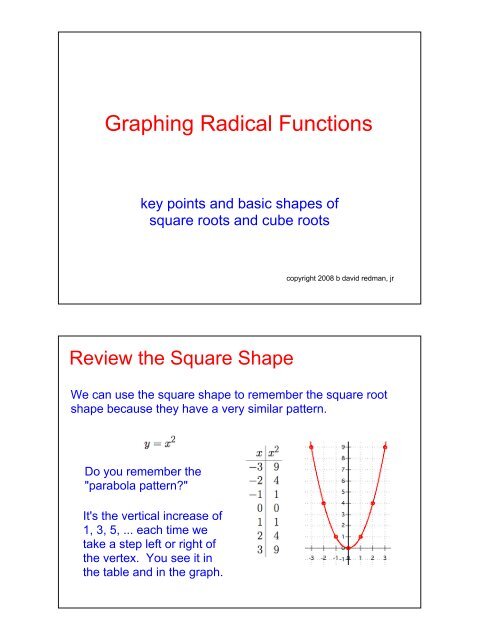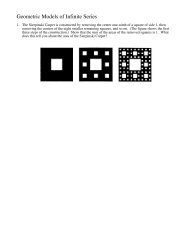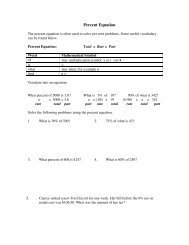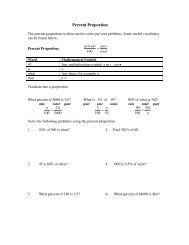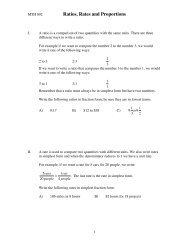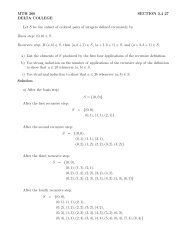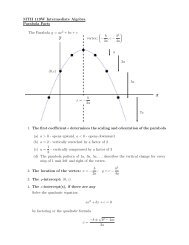You also want an ePaper? Increase the reach of your titles
YUMPU automatically turns print PDFs into web optimized ePapers that Google loves.
The Basic Square Root ShapeThe shape of the basic square root function is literally"half of a parabola on its side."A table of the key points looks exactly like a table for thesquare function, with the values of x and y reversed!The 1, 3, 5, ... pattern is shown in the x-values of the tableand horizontal change in the graph.Translating the Square Root ShapeYou can graph many square root functions by locating thesefour key points where the square root produces 0, 1, 2, 3, ...(-5,0)(-4,1)(-1,2)(4,3)To produce these values in this function we need x + 5to be equal to 0, 1, 4, 9, ... By setting x + 5 equal to 0,1, 4, 9, ..., we find the values of x for the key points.
Scaling and TranslatingIf the expression inside the square root is a linear expression,ax + b, then the basic shape has been scaled and translated.By setting 4x + 3 equal to 0, 1,4, 9, ..., we find the x-values forthe key points of this function.Calculate the fourth x-value and see for yourself.Scaling and TranslatingAfter we have calculated the x-values of the key points, wecan select an appropriate scale and plot the key points.We still see the 1, 3, 5, ... pattern ofhorizontal change in this shape, buthere it appears as 1/4, 3/4, 5/4, ...(-1/2,1)(-3/4,0)
One More Square Root ExampleWhat will be the effect of the negative number in front of the xin this example?This time you calculate the x-values of the last two keypoints.What horizontal scale should we use to be ableto plot these points as simply as possible?One More Square Root ExampleTo plot these points quickly, the most natural scale to use onthe x-axis would be counting by 1/3.(-7/3,3)(1/3,1)The 1, 3, 5, ... pattern appears here as -1/3, -3/3, -5/3,... The negative coefficient of x caused the graph toincrease from right to left.
The Basic Cube Root ShapeThe idea of locating the key points was so successfulgraphing basic square root functions, let's try it on cube roots.The table of key points for the cube root function looks like atable for the cube function, with the values of x and y reversed.These five key points form the basic cube root pattern.Translating the Cube Root ShapeLocate the five key points where the following cube rootfunction produces -2, -1, 0, 1, 2.(3,1)(10,2)(-6,-2)(2,0)(3,-1)To produce these values in this function we need x - 2to be equal to -8, -1, 0, 1, 8. That allows us to find thex-values of the key points of this function.
Scaling and TranslatingLet's calculate the key points of the following cuberoot function.By setting 3x - 2 equal to -8, -1,0, 1, 8, we find the x-values forthe key points of this function.Calculate the last two x-values yourself.Scaling and TranslatingAfter we have calculated the x-values of the key points, wecan select an appropriate scale and plot the key points.A different x-scale, but still the characteristic cube rootshape.
One More Cube Root ExampleCan you visualize the shape and orientation of this function?You calculate the x-values ofthe other three key points.What horizontal scale should we use to plot thesepoints as simply as possible?One More Cube Root ExampleTo plot these points quickly, the most natural scale to use onthe x-axis would be counting by 1/4.(3/2,-1)(13/4,-2)Now we recognize this pattern even when it is reversed!
SummaryKnow the key points and you candraw any shape in the universe!Choose the scale on your axes thatmakes your key points easy to plot!A few, simple algebraiccalculations can go a long way!


